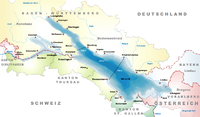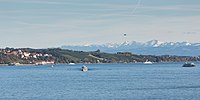
The House of Bonaparte is a former imperial and royal European dynasty of Italian origin. It was founded in 1804 by Napoleon I, the son of Corsican nobleman Carlo Buonaparte and Letizia Buonaparte. Napoleon was a French military leader who rose to power during the French Revolution and who, in 1804, transformed the French First Republic into the First French Empire, five years after his coup d'état of November 1799. Napoleon and the Grande Armée had to fight against every major European power and dominated continental Europe through a series of military victories during the Napoleonic Wars. He installed members of his family on the thrones of client states, expanding the power of the dynasty.

Louis Napoléon Bonaparte was a younger brother of Napoleon I, Emperor of the French. He was a monarch in his own right from 1806 to 1810, ruling over the Kingdom of Holland. In that capacity, he was known as Louis I.

Napoleon III was the first president of France from 1848 to 1852, and the last monarch of France as Emperor of the French from 1852 until he was deposed on 4 September 1870.
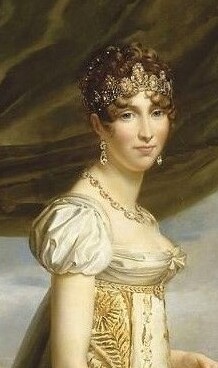
Hortense Eugénie Cécile Bonaparte was Queen consort of Holland. She was the stepdaughter of Emperor Napoléon I as the daughter of his first wife, Joséphine de Beauharnais. Hortense later married Napoléon I’s brother, Louis Bonaparte, who had been made King of Holland, making her her stepfather’s sister-in-law. She was the mother of Napoléon III, Emperor of the French; Louis II of Holland; and Napoléon Louis Charles Bonaparte who died at the age of four. She also had an illegitimate son, Charles, Duke of Morny, with her lover, the Comte de Flahaut.

Joséphine Bonaparte was Empress of the French as the first wife of Emperor Napoleon I from 18 May 1804 until their marriage was annulled on 10 January 1810. As Napoleon's consort, she was also Queen of Italy from 26 May 1805 until the 1810 annulment. She is widely known as Joséphine de Beauharnais.

Eugène Rose de Beauharnais was a French nobleman, statesman, and military commander who served during the French Revolutionary Wars and the Napoleonic Wars. Through the second marriage of his mother, Joséphine de Beauharnais, he was the stepson of Napoleon Bonaparte. Under the French Empire he also became Napoleon's adopted son. He was Viceroy of the Kingdom of Italy under his stepfather, from 1805 to 1814, and commanded the Army of Italy during the Napoleonic Wars. Historians consider him one of Napoleon's most able relatives.

DoñaMaría Eugenia Ignacia Agustina de Palafox y Kirkpatrick, 19th Countess of Teba, 16th Marquise of Ardales, known as Eugénie de Montijo, was Empress of the French from her marriage to Napoleon III on 30 January 1853 until the Emperor was overthrown on 4 September 1870. From 28 July to 4 September 1870, she was the de facto head of state of France.
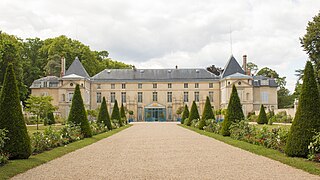
The Château de Malmaison is a French château situated near the left bank of the Seine, about 15 kilometres (9.3 mi) west of the centre of Paris, in the commune of Rueil-Malmaison.

Auguste Charles Joseph de Flahaut de La Billarderie, Comte de Flahaut was a French general during the Napoleonic Wars, a senator, and later in his life, a French ambassador to the Court of St James's. He had a son with Napoleon's stepdaughter, Hortense de Beauharnais.

Marie Julie Clary, was Queen of Naples, then of Spain and the Indies, as the wife of Joseph Bonaparte, who was King of Naples from January 1806 to June 1808, and later King of Spain and the Spanish West Indies from 25 June 1808 to June 1813.

The Crown of Empress Eugénie is the consort crown that was made for Eugénie de Montijo, empress consort of Napoleon III, Emperor of the French. Although neither she or her husband had a coronation ceremony, a crown was specially created for her on the occasion of the 1855 Exposition Universelle in Paris. The gold crown is set with diamonds and emeralds in eagle and palmette motifs, and is topped by a monde.

Napoléon-Louis Bonaparte was King of Holland for less than two weeks in July 1810 as Louis II. He was a son of Louis Bonaparte and Queen Hortense. His father was the younger brother of Napoleon I of France who ruled the Napoleonic Kingdom of Holland from 1806 to 1810. His mother was the daughter of Josephine de Beauharnais, Napoleon's first wife. His younger brother, Louis-Napoléon, became Emperor of the French in 1852 as Napoleon III.

Salenstein is a municipality in Kreuzlingen District in the canton of Thurgau in Switzerland.

The succession to the throne of the French Empire was vested by Bonapartist emperors in the descendants and selected male relatives of Napoleon I. Following the end of the Second French Empire in 1870, Bonapartist pretenders descended from Napoleon I's brothers have maintained theoretical claims to the imperial office.

"Partant pour la Syrie" is a French patriotic song, the music of which was written by Hortense de Beauharnais and the text by Alexandre de Laborde, in or about 1807.
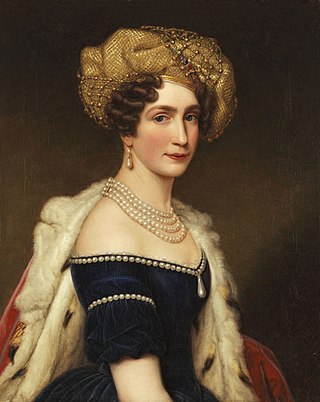
Princess Augusta of Bavaria, Duchess of Leuchtenberg was the second child and eldest daughter of Maximilian I Joseph of Bavaria and Princess Augusta Wilhelmina of Hesse-Darmstadt. By marriage, she was a French princess.

The Coronation of Napoleon is a painting completed in 1807 by Jacques-Louis David, the official painter of Napoleon, depicting the coronation of Napoleon at Notre-Dame de Paris. The oil painting has imposing dimensions – it is almost 10 metres (33 ft) wide by a little over 6 metres (20 ft) tall. The work is on display at the Louvre Museum in Paris.

Eugénie Hortense Auguste Napoléone de Beauharnais, princess of Leuchtenberg was a Franco-German princess. She was the second daughter of Eugène de Beauharnais and Princess Augusta of Bavaria, and a member of the House of Beauharnais. In 1826 she married Constantine, Prince of Hohenzollern-Hechingen.
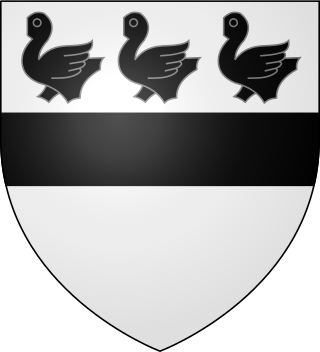
The House of Beauharnais is a French noble family. It is now headed by the Duke of Leuchtenberg, descendant in male line of Eugène de Beauharnais.

Allaman Castle is a castle in the municipality of Allaman in the canton of Vaud in Switzerland. It has its origins in the 11/12th Century but the main components were built by Louis, Duke of Savoy - Count de Vaud, in 1253. It is listed in the Swiss Inventory of Cultural Property of National and Regional Significance.






















